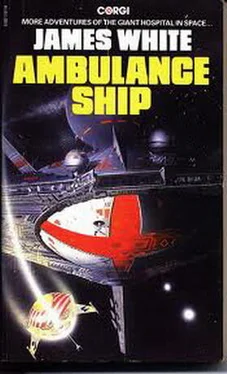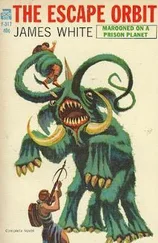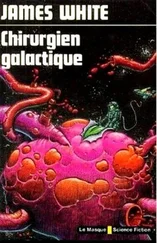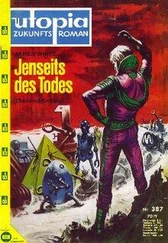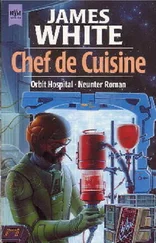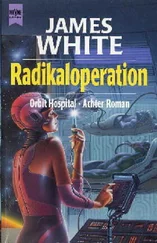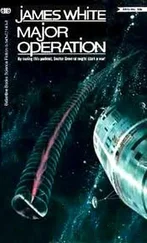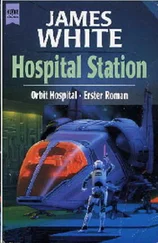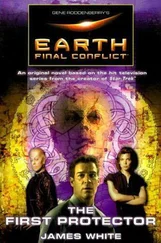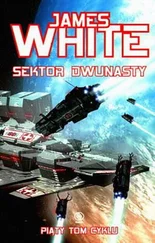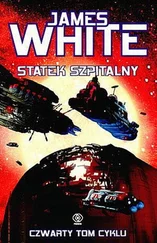“It is clear what happened here,” said the Captain. “Two members of the species that crew this ship died when the large one broke free because of inadequate restraints, and presumably the survivors Prilicla detected were unable to cope with the situation and released a distress beacon.”
One of the smaller beings, which had sustained multiple incised and punctured wounds, lay like a piece of torn and rumpled carpet under its killer’s hind feet. Its companion, although just as dead, had suffered fewer wounds and had almost made its escape through a low opening in the wall at deck level before being immobilized and crushed by one of its attacker’s forefeet. It had also, before it died, been able to inflict several deep puncture wounds on the larger alien’s underside, and its broken-off horn or sting was still deeply embedded in one of them.
“I agree,” said Conway. “But one thing puzzles me. The blind ones appear to have modified their ship to accommodate the larger life-form. Why would they go to so much trouble to capture such a dangerous specimen? They must need it very badly or consider it extremely valuable for some reason to risk confining it with a blind crew.
“Possibly they have weapons that reduce the risk,” Fletcher said, “longer range, more effective weapons than that horn or sting, which these two omitted to carry for some reason and died because of the omission.”
“What kind of long-range weapon,” asked Conway, “could be developed by a being with only a sense of touch?”
Murchison tried to head off the argument that was impending. “We don’t know for certain that they have only a sense of touch, although they are blind. As for the value of the large life-form to them, it could be a fast-breeding source of food, or its tissues or organs might contain important sources of valuable medication, or the reason maybe a completely alien one. Excuse me.”
She switched on her suit radio. “Naydrad, we have three cadavers to transfer to the lab. Move them in the litter to avoid additional damage to the specimens by decompression.” She turned to Conway and the Captain. “I don’t think the other members of the crew would object to my opening up their friends, especially since the large one has already begun the process.”
Conway nodded. They both knew that the more she was able to discover about the physiology and metabolism of the two dead specimens, the better would be their chances of helping the surviving blind ones.
With Fletcher’s help they extricated the large cadaver from its cage and from the strange assortment of metal rods and bars that were pressing it against the deck. They had to widen the opening it had made in the grill. This required the combined efforts of the three of them and gave some indication of the strength of the being who had forced it apart. When they had the large alien free, its tentacles opened out and practically blocked the corridor as it floated weightless in the confined space.
While they were pushing it towards the airlock, Murchison said, “The deployment of the legs and tentacles is similar to the Hudlar FROB life-form, but that carapace is a thicker ELNT Melfan shell without markings, and it is plainly not herbivorous. Considering the fact that it is warm-blooded and oxygen-breathing and its appendages show no evidence of the ability to manipulate tools or materials, I would tentatively classify it as FSOJ, and probably nonintelligent.”
“Certainly non-intelligent, considering the circumstances,” said Fletcher as they returned to the caged section of corridor. “It was an escaped specimen, ma’am.”
“We medical types,” said Murchison, smiling, “never commit ourselves, especially where a brand-new life-form is concerned. But right now I wouldn’t even try to classify the blind ones.
Since she was the smallest person there, it was Murchison who wriggled carefully through the damaged grill and between the projecting rods and bars. If it had not been for the large alien warping a number of the bars out of true, she would not have been able to reach the blind one at all.
“This,” she said breathlessly as she reached the cadaver, “is a very strange cage.”
Although it was brightly lit, they could not see the other end of the caged section of corridor, because it followed the curvature of the ship, which at this distance from the center was sharp enough to keep them from seeing more than ten meters into it. The corridor walls and ceiling of the section they could see, however, were covered with projecting metal bars and rods. Some of them had sharp tips, others had spatulate ends and a few of them terminated in something that resembled a small metal ball covered in blunt spikes. The metal bars projected from slits in the walls, and the slots were long enough to allow their individual bars a wide angle of travel either up and down or from side to side. The rods protruded from circular holes and collar pieces in the ceiling and were designed only to move in and out.
“It is strange to me, too, ma’am,” said the Captain. “None of the e-t technology I’ve studied gives me any ideas. For one thing, it is a large cage, or should I say a very long cage, if it is continued around the ship. Perhaps it was meant to house more than one specimen, or the one specimen required space in which to exercise. I’m guessing, but I would say that the bars and rods projecting into the corridor formed some kind of restraint whereby the specimen could be immobilized in any part of the caged section for feeding purposes or for physical examination.”
“A pretty good guess, I’d say,” said Conway. “And if there was a malfunction in the mobile restraints, then the metal grill formed a safety backup that couldn’t, on this occasion, withstand the specimen’s attack. But I’m wondering just how far this corridor follows the radius of the ship. Extending this arc to the other side of the vessel places it in the area where Prilicla detected the two survivors. One of those survivors, according to Prilicla, was emoting anger on a very basic, perhaps animal, level while the other being’s emotional radiation was more complex.
“Let’s suppose,” Conway went on, “that there is another large alien at the other end of the corridor cage, maybe even outside the other end of the cage, with a badly injured blind one who wasn’t as successful as its crew-mate here in killing the brute—”
He broke off as Naydrad’s voice sounded in the suit phones, saying that it was outside with the pressure litter.
Murchison pushed the first blind one towards the lock. “Wait for a few minutes, Naydrad, and you can load all three specimens.”
Fletcher had been staring at Conway while the doctor was talking, plainly not liking the thought of another large FSOJ being in the ship. He pointed anxiously at the second blind one’s body. “This one nearly escaped after killing the FSOJ with its horn. If we knew where it was trying to escape to, we might know where to look for its crew-mate who did escape.”
“I’ll help you,” said Conway.
Time for the survivors, whichever species they belonged to, was fast running out.
At deck level there was a low rectangular opening, which was wide and deep enough to allow entry to a blind one. Nearly one third of its flat, circular body was inside the opening, and when they tried to remove it they encountered resistance and had to give the creature a gentle tug to pull it free. They were pushing it towards Murchison, who was waiting to load it into the airlock with the other two specimens, when there was an interruption on the suit frequency.
“Sir! A panel is swinging open topside. It looks like … it is an antenna being deployed.”
“Priicla,” Conway called quickly, “the survivors. Is one of them conscious?”
Читать дальше
